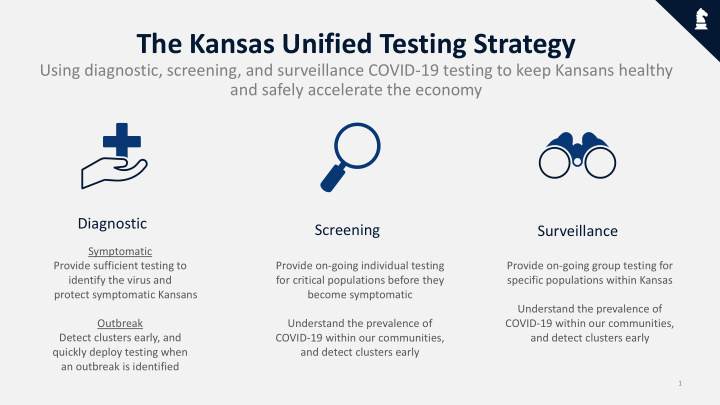



The Kansas Unified Testing Strategy Using diagnostic, screening, and surveillance COVID-19 testing to keep Kansans healthy and safely accelerate the economy Diagnostic Screening Surveillance Symptomatic Provide sufficient testing to Provide on-going individual testing Provide on-going group testing for identify the virus and for critical populations before they specific populations within Kansas protect symptomatic Kansans become symptomatic Understand the prevalence of Outbreak Understand the prevalence of COVID-19 within our communities, Detect clusters early, and COVID-19 within our communities, and detect clusters early quickly deploy testing when and detect clusters early an outbreak is identified 1
Kansas Unified Testing strategy | Steps Involved in Testing Testing Intervention Sourcing 1 2 3 4 5 6 7 8 Identify Sample Quarantine Source testing Source lab Transport Process the Share populations those & contact supplies capacity tests to lab results the results to test populations trace • Expand State Procure supplies Set testing Source and train Arrange safe, Ensure reliable Establish rapid Set up effective • Testing lab capacity strategy by samplers for reliable logistics lab capacity reporting contact tracing • Contract hardware population collection between through ongoing mechanism infrastructure • Reagents private labs group including sampling sites monitoring • PPE for those • Who to test Communicate and labs Communicate Communicate • How often to sampling testing program actions for those protocols to test to public to testing positive public to drive Arrange testing increase compliance sites, etc. awareness 2
Kansas Unified Testing strategy | Public Health response tools to be used differently across priority populations based on public health risk & virus prevalence Investigate Investigate Investigate 1 Nursing Homes Outbreaks + Outbreaks Outbreaks + Screening Meatpacking Surveillance (Low Risk) 2 K-12 schools (High Risk) Nursing Homes (Medium Risk) 3 Communities of Color, Tribal Populations Corrections & County Jails 4 Meatpacking Screening Communities of Color, Tribal Populations 5 First Responders Universities & Community Colleges 6 Corrections & County Jails First Responders 7 School Bus Drivers Prevalence Transportation (non school bus drivers) K-12 Schools 8 Healthcare Providers School Bus Drivers 9 Service Providing Establishments Surveillance Healthcare Providers Service Providing Establishments Other Manufacturing 10 Universities & Community Colleges Aerospace Warehouse and Distribution Centers Workers 11 Warehouse and Distribution Centers Critical trades & Agriculture 12 Transportation (non school bus drivers) 13 Other Manufacturing Social Services & Childcare Outbreak 14 Aerospace 15 Social Services & Childcare 16 Critical Trades & Agriculture Public Health Risk Note: Public Health Risk defined as vulnerability of population & widespread transmission risk 3 Source: KUMC, KDHE, OSHA Each population’s public health risk and prevalence will evolve over time – thus moving the dots on the graph
Recommend
More recommend